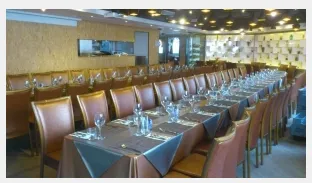
Here's why Barclays believes recently listed Tsui Wah is a good buy
Fast-casual players are more flexible to raise prices than fastfood players.
Barclays see key issues in the restaurant chain space to be scalability, standardisation, food safety, store productivity and the ability to pass on costs. These, it said, are all important in sustaining the rapid growth of restaurant chains in Hong Kong, China and Taiwan.
Analysts of Barclays met with the CFO of recently listed Hong Kong fast-casual segment player, Tsui Wah, Mr John Yang.
Here it take a look at Tsui Wah’s business model and how its experience in Hong Kong and China relates to stocks it covers:
Tsui Wah: 31 restaurants in Hong Kong/China/Macau: Tsui Wah is a Hong Kong company founded in 1989. It has 22 Tsui Wah-branded restaurants in HK, 6 in China and 1 in Macau, as well as 1 store each under the Tsui Wah EATery and Tsui Wah Concept brands in HK. Its Tsui Wah restaurants (known as “Cha Chaan Tengs”) are an iconic representation of HK’s dining culture, combining Cantonese, Western and Asian foods. Its Cha Chaan Tengs have communal seating, which minimises the number of idle seats, offer 15-24 hours of service, and provide takeaway and delivery services. The company listed on the HK Stock Exchange on 26 Nov 2012.
Competitive landscape fragmented, room to grow: Like the general restaurant industry, the Cha Chaan Teng segment in HK is fragmented. There are only 4 operators with more than 10 restaurants in HK (in 2011, according to Frost & Sullivan), and they together only have 7% revenue share. In 2011, Tsui Wah was the market leader in the HK Cha Chaan Teng segment by revenues and number two player in terms of number of restaurants. For China, Frost & Sullivan estimates the segment would see a 29.3% revenue CAGR over 2012-16E, faster than the 13.6% CAGR estimate for the China restaurant/catering industry overall due to Cha Chaan Teng’s earlier stage of development and low penetration. Cha Chaan Tengs have a relatively low penetration rate in China and accounted for only 3,728 restaurants in China as of 2011. The China landscape is fragmented as well, with only six operators with more than 10 restaurants, and combined they had 6.7% market share in 2011 (according to Frost & Sullivan). Bei Feng Tang is the largest China player with 32 restaurants.
Store expansion plans, FY13 target met: Tsui Wah has met its FY13 (Mar year-end) store opening target with 5 openings in HK, 4 openings in Shanghai and 1 store presence in Wuhan. In terms of expansion, like most restaurant companies under our coverage, Tsui Wah plans to achieve a certain scale in selected regions so that it can utilise central kitchens and attain economies of scale. For HK, it targets 4 openings respectively in FY14E and FY15E. For Yangtze River Delta, primarily Shanghai, it targets 5 openings each in FY14E and FY15E. For Southern China, where it has no presence currently, it targets 2 openings in FY14E and 5 openings in FY15E. For Wuhan, it plans to open 1 new restaurant in FY14E and FY15E. This means the company expects to reach 58 Tsui Wah restaurants by end-FY15, compared to the 29 it has now (excluding potential further openings of Tsui Wah EATery and Tsui Wah Concept stores).
HK vs China: Pricing and store productivity: Tsui Wah is positioned in the fast-casual segment and its pricing is higher than fast-casual restaurant chain Ajisen, which sees per-customer spending of HK$60 in HK and RMB40 in China. For the HK stores, Tsui Wah targets average spending per person of HK$70, while for China it is more at RMB80. Tsui Wah’s average spending per invoice is higher in China at HK$190 vs HK HK$74 (China is more geared towards lunch and dinners, rather than breakfast and snacks). Stores in China are larger at 7,000-10,000 sq ft (vs HK’s 3,000 sq ft), and therefore China achieves higher daily sales per store at HK$152 vs HK’s HK$122. However, if we adjust for floor area, China’s per sq ft sales are around 44% of HK’s in FY12. The company’s HK stores are more productive for breakfast, afternoon teas and late-night snacks, leading to a high average number of invoices per table per day at 25 in HK (vs China at just 8).
Further SSS growth: Tsui Wah said its positioning for the mid- to high-end market makes it relatively easier to hike prices (and help drive SSS) even when food inflation pressure is not high (compared to lower-end restaurants such as Ajisen, Hop Hing and Cafe de Coral whose target customer base is more low end). For HK, Tsui Wah is implementing average 5-6% price increases per year and adds new menu items to assist in indirectly increasing prices. The company believes another 5-6% y/y traffic increase across its stores in HK is achievable. It plans to strengthen delivery services as well, which further helps SSS. For China, Tsui Wah plans to implement a similar 5-6% price increase this year, but traffic increases would further add to SSS as: 1) afternoon tea and late night snack offerings are becoming more popular; and 2) generally, customer traffic is increasing. Of note, the company’s 3QFY13 China SSS was at mid-20% growth, which we believe is much higher than Gourmet Master, Ajisen and Hop Hing achieve.
HK vs China: Profitability: According to the company, China achieves a higher store-level EBIT margin than HK stores, at around 24% vs. 18%. Gross margins are similar, but rentals and staff costs as a percentage of sales are lower in China. China store-level EBIT margins are higher than HK’s for other restaurant chains such as Ajisen and Cafe de Coral (Not rated) as well.
Sourcing and food safety: As for all the restaurant stocks under our coverage, food at Tsui Wah is centrally procured both in HK and China stores, which minimises the chance of food safety issues. For HK, Tsui Wah sources ingredients from a number of selected suppliers with which it has long-standing relationships, some are suppliers in China, and some are importers in HK who in turn source from overseas countries. Tsui Wah has more than 100 suppliers. For China, the company undergoes a more rigorous internal approval process in selecting suppliers and carries out periodic testing on certain raw materials.
Standardisation and efficiency (SKUs, chefs, central kitchens): Menus at Tsui Wah, like many of the restaurant chains we cover, are standardised with minor item and pricing differences. There are around 170 SKUs in both HK and China stores, and this is much higher than for fast-food chains such as Ajisen and Hop Hing. Standardisation and efficiency in HK is achieved through 50% of foods being processed in the central kitchen, and with trained chefs with specialised skills in stores (e.g. noodles, buns, drinks, etc.). HK has one central kitchen and the company is trying to locate a second. In Shanghai, it plans to open a permanent central kitchen venue and will open a leased kitchen in May/June. It plans to open a central kitchen for Southern China as well. For staff training, HK has a large enough employee base to train waiters and staff internally (similar to how other HK/China restaurant chains do it). Whereas for China, new waiters are trained by a consulting agency, and chefs are hired from a Guangdong culinary school which tailors part of its programme for Tsui Wah.
Margins largely manageable due to SSS growth: While the company does not provide guidance on margins, it said that wage and rental increases are manageable since it is growing SSS (through traffic and passing on costs through ASP increase). Food costs have been manageable in recent months but the company said this is the main source of potential pressure on margins. In this respect, we believe quick-service restaurants in general are less able to directly raise prices (in the event there is no obvious food inflation) and have to rely more on menu reshuffling and new products to indirectly raise prices. Restaurant chains targeting mid- to high-end customers (fast-casual like Tsui Wah, and full restaurants) find customers are generally more receptive to price increases. We believe the slower SSS growth we have been seeing for quick service restaurants over the past few months is because ASP increases are more limited as food inflation is not as serious as it was a year ago.
Capex, payback and quick breakeven: It costs around HK$9mn to open a store, according to Tsui Wah. The company expects HK$260mn and HK$214mn capex in FY14E and FY15E, which the CFO said would be funded by IPO proceeds and internally. It takes 1-4 months for a new store in HK to break even, and just 1 month for its recently opened Shanghai store. By comparison, it takes 6 months for a new Ajisen store to break even (even before the negative media reports on its soup base in July/August 2011). Tsui Wah’s Hong Kong stores’ payback period is usually 12 months, its first China store was 15-16 months and its newer stores less.



















 Advertise
Advertise








